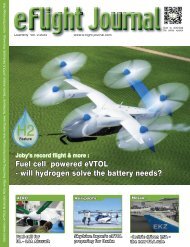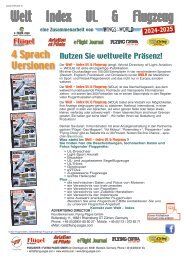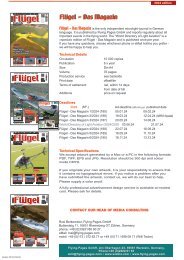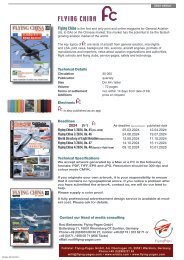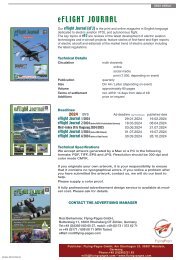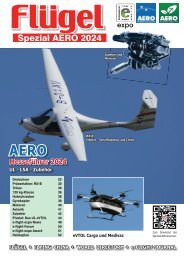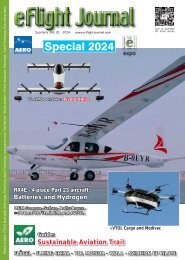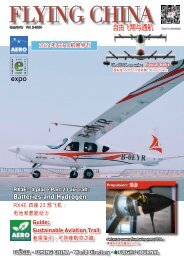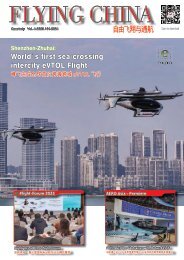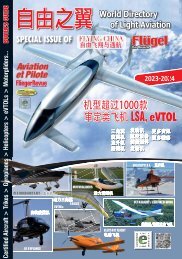Freddy Gyllensten, Jörg Janning Challenges in Designs for Electric Propulsion
You also want an ePaper? Increase the reach of your titles
YUMPU automatically turns print PDFs into web optimized ePapers that Google loves.
<strong>Challenges</strong> <strong>in</strong> <strong>Designs</strong> <strong>for</strong> <strong>Electric</strong> <strong>Propulsion</strong> Drivetra<strong>in</strong>s <strong>in</strong> Aviation<br />
Dr. <strong>Freddy</strong> <strong>Gyllensten</strong>, Dr. <strong>Jörg</strong> <strong>Jann<strong>in</strong>g</strong><br />
17 October 2019, e-flight Forum 2019 (Shijiazhuang)
Wolong – Introduction<br />
Founded 1984<br />
by Mr. Jiancheng Chen<br />
<strong>in</strong> Zhejiang<br />
18,000<br />
Employees<br />
61<br />
Hold<strong>in</strong>g subsidiaries<br />
5.6B<br />
Sales revenues<br />
(USD) <strong>in</strong> 2018<br />
4.7B<br />
Total assets<br />
(USD) <strong>in</strong> 2018<br />
© Wolong <strong>Electric</strong><br />
10/29/2019
Company brands and history<br />
Wolong has achieved a rapid growth through global acquisitions,<br />
which have extended the company’s motor manufactur<strong>in</strong>g<br />
experience up to 140 years.<br />
Founded <strong>in</strong>1878<br />
Founded <strong>in</strong> 1883<br />
Founded <strong>in</strong>1897<br />
Founded <strong>in</strong>1970<br />
Right to use GE mark <strong>for</strong> 10 years<br />
Founded <strong>in</strong>1984<br />
Founded <strong>in</strong>1882<br />
Founded <strong>in</strong>1919<br />
Founded <strong>in</strong>1961<br />
Founded <strong>in</strong>1980<br />
© Wolong <strong>Electric</strong><br />
10/29/2019
Global Footpr<strong>in</strong>t<br />
Germany<br />
• 39 factories <strong>in</strong> 3 cont<strong>in</strong>ents<br />
Vietnam<br />
CNE<br />
• Global Research Centre<br />
Explosion proof, special<br />
motors<br />
FHP/IHP Motor<br />
Explosion-proof motor,<br />
generator, synchronous<br />
motor<br />
UK<br />
Germany<br />
Poland<br />
Austria<br />
Serbia<br />
Italy<br />
Ch<strong>in</strong>a<br />
Headquarter<br />
Mexico<br />
Mexico<br />
Vietnam<br />
Appliance motors<br />
EVs and <strong>in</strong>d. motors<br />
UK<br />
Austria<br />
J<strong>in</strong>an Plant<br />
Industrial motors<br />
Project motors, AC, DC and<br />
PM motors<br />
Power up to 800 MW<br />
Industrial, Special and<br />
Appliance motors<br />
Home Appliance Motor<br />
© Wolong <strong>Electric</strong><br />
10/29/2019
Today – Typical <strong>in</strong>stalled power and mission energy <strong>for</strong> aircrafts<br />
More electric wide-body aircraft with highest generat<strong>in</strong>g capacity<br />
Typical <strong>in</strong>stalled power <strong>for</strong> different aircraft types (MW)<br />
Typical mission energy <strong>for</strong> different aircraft types (MWh)<br />
Boe<strong>in</strong>g 787 Dreaml<strong>in</strong>er<br />
Variable frequency starter generator<br />
1 MVA<br />
Medium range based on 2.5h flight<br />
Wide-body based on 13.5h flight<br />
4 x 250kVA<br />
(Source: Boe<strong>in</strong>g)<br />
(Source: Rolls-Royce)<br />
© Wolong <strong>Electric</strong><br />
10/29/2019
Tomorrow – <strong>Challenges</strong> <strong>for</strong> electric propulsion<br />
Gravimetric energy density of state-of-the-art Li-batteries (Wh/kg)<br />
Theoretical weight of a battery <strong>for</strong> different aircraft types of today (metric tons)<br />
>500<br />
280<br />
10 years of prediction<br />
Battery status<br />
• State-of-the-art batteries today use Lithium technology and<br />
have a gravimetric energy density of around 280 Wh/kg<br />
• It is predicted that the energy density will <strong>in</strong>crease to around<br />
500 Wh/kg by the year 2030<br />
Assumptions<br />
• Batteries with energy density of 500 Wh/kg, as predicted available <strong>in</strong> 2030<br />
• Same mission energy as <strong>in</strong> fuel-driven eng<strong>in</strong>es (which is not fully true <strong>for</strong><br />
more efficient electric propulsion, but exposes the challenges)<br />
Conclusions<br />
• It will be very difficult to replace long-haul wide-body aircraft eng<strong>in</strong>es with<br />
electric propulsion us<strong>in</strong>g batteries (hybrid concepts will develop first)<br />
• Lighter aircrafts with short range have the best characteristics <strong>for</strong> full<br />
utilization of electric propulsion and will take lead <strong>in</strong> commercial<br />
implementation<br />
(Source: Roland Berger)<br />
© Wolong <strong>Electric</strong><br />
10/29/2019
Current per<strong>for</strong>mance of electrical mach<strong>in</strong>es<br />
Rated power density (kW/kg)<br />
Rated torque density (Nm/kg)<br />
(Permanent magnet mach<strong>in</strong>es only)<br />
© Wolong <strong>Electric</strong><br />
10/29/2019<br />
Source: A- EL-Refaie, M. Osama, ”High specific power electrical mach<strong>in</strong>es: a system perspective”, IEEE, 2017.
Basic per<strong>for</strong>mance factors of electrical mach<strong>in</strong>es<br />
The size and weight of an electrical mach<strong>in</strong>e is <strong>in</strong> pr<strong>in</strong>ciple governed by the required torque<br />
Increas<strong>in</strong>g power and power density can be done by <strong>in</strong>creas<strong>in</strong>g speed<br />
‣ Mach<strong>in</strong>es with very high speed tend to have low pole numbers<br />
4 poles<br />
Mach<strong>in</strong>es with low speed have the potential to <strong>in</strong>crease torque and<br />
torque density by hav<strong>in</strong>g high pole numbers and large airgap diameters<br />
24 poles<br />
© Wolong <strong>Electric</strong><br />
10/29/2019
Basic per<strong>for</strong>mance factors of electrical mach<strong>in</strong>es (2)<br />
The rated per<strong>for</strong>mance <strong>in</strong> electrical mach<strong>in</strong>es is ultimately limited by the maximum allowed<br />
temperatures <strong>in</strong> critical components (primarily <strong>for</strong> w<strong>in</strong>d<strong>in</strong>g <strong>in</strong>sulations and bear<strong>in</strong>gs)<br />
For a given rated speed, the torque and power of an electrical mach<strong>in</strong>e<br />
can be <strong>in</strong>creased by:<br />
• Reduc<strong>in</strong>g the losses (copper, iron, friction, parasitic)<br />
• Increas<strong>in</strong>g the operat<strong>in</strong>g temperature (if the design and materials<br />
allows)<br />
• Enhanc<strong>in</strong>g the cool<strong>in</strong>g per<strong>for</strong>mance (gives temperature marg<strong>in</strong><br />
that can be utilized)<br />
Note:<br />
Industrial motors are<br />
normally run at w<strong>in</strong>d<strong>in</strong>g<br />
temperatures below 120˚C<br />
(class B tempererature rise)<br />
For a given mach<strong>in</strong>e dimension the per<strong>for</strong>mance can be enhanced by:<br />
• Tighter pack<strong>in</strong>g of copper w<strong>in</strong>d<strong>in</strong>g<br />
• Shorten<strong>in</strong>g end-w<strong>in</strong>d<strong>in</strong>gs<br />
• Lower loss materials (e.g. th<strong>in</strong>ner electric steel lam<strong>in</strong>ations <strong>for</strong><br />
SiFe, CoFe steel, amorphous steel, superconduct<strong>in</strong>g materials)<br />
© Wolong <strong>Electric</strong><br />
10/29/2019
Design Requirements of <strong>Electric</strong>al Mach<strong>in</strong>es <strong>for</strong> Aerospace<br />
• High Efficiency ( > 96%);<br />
• Super Compact (4.5-6 kW/kg);<br />
• High Speed (up to 40,000 rpm);<br />
• Safety and reliability (Certifications);<br />
• Subject to possible severe Environment;<br />
• Compact and Reliable Frequency Converter;<br />
© Wolong <strong>Electric</strong><br />
10/29/2019
Stresses on e-Aircraft <strong>Propulsion</strong> Motors<br />
<strong>Electric</strong>al stress<br />
• Pulse voltage modulation<br />
• High frequency pulses<br />
• Fast voltage rise time<br />
Mechanical stress<br />
• Acceleration: Max. 10-20g<br />
• Vibrations<br />
Thermal stress<br />
• Operat<strong>in</strong>g temperatures above 200˚C<br />
Environmental stress<br />
• Oil cool<strong>in</strong>g<br />
• Moisture<br />
• Metal particles<br />
• High altitudes<br />
© Wolong <strong>Electric</strong><br />
10/29/2019
Comparison of <strong>Electric</strong>al Mach<strong>in</strong>e Topologies<br />
Source:<br />
Prof. Thomas Jahns<br />
IEEE Electrification Magaz<strong>in</strong>e<br />
MARCH 2017<br />
Stator<br />
Rotor<br />
Liquid-cooled<br />
PM Motor<br />
© Wolong <strong>Electric</strong><br />
10/29/2019
Neodymium Iron Boron (NdFeB) Permanent Magnets<br />
• The magnets, once magnetized, cont<strong>in</strong>ually deliver magnetic<br />
flux <strong>in</strong>to the mach<strong>in</strong>e’s air gap without external excitation<br />
Ch<strong>in</strong>a has 65% of<br />
Neo Magnet Material<br />
reserve worldwide<br />
• No Rotor Joule Losses Dur<strong>in</strong>g Operation<br />
• Mach<strong>in</strong>e losses concentrated on stator side<br />
• <strong>Challenges</strong>:<br />
• Surface Treatment and Coat<strong>in</strong>g<br />
• Safety Dur<strong>in</strong>g Magnet Assembly<br />
• Demagnetization dur<strong>in</strong>g operation<br />
• Temperature,<br />
• Short circuit current,<br />
• Environment<br />
© Wolong <strong>Electric</strong><br />
10/29/2019
W<strong>in</strong>d<strong>in</strong>g Concepts<br />
Random w<strong>in</strong>d<strong>in</strong>g Concentrated w<strong>in</strong>d<strong>in</strong>g Hair-p<strong>in</strong> w<strong>in</strong>d<strong>in</strong>g<br />
+ Standard <strong>in</strong> low voltage electric<br />
mach<strong>in</strong>ery <strong>for</strong> <strong>in</strong>dustrial applications<br />
+ Low AC resistance per default<br />
+ Produces s<strong>in</strong>usoidal flux <strong>for</strong> low<br />
parasitic effects<br />
− Relatively low copper slot fill factor<br />
and long end-w<strong>in</strong>d<strong>in</strong>gs result <strong>in</strong> high<br />
DC resistance, poor heat transfer<br />
and low torque density<br />
− Several manufactur<strong>in</strong>g steps that<br />
can <strong>in</strong>volve both automated and<br />
manual handl<strong>in</strong>g<br />
Litz wire<br />
+ Standard <strong>in</strong> low voltage electric<br />
mach<strong>in</strong>ery <strong>for</strong> servomotors/robotics<br />
applications<br />
+ Enables high level of automation<br />
+ Enables short end-w<strong>in</strong>d<strong>in</strong>gs and<br />
high copper slot fill factor <strong>for</strong> low<br />
DC resistance<br />
− Produces high amount of harmonic<br />
flux which is load dependent and<br />
can create severe parasitic effects<br />
like losses <strong>in</strong> core and permanent<br />
magnets<br />
− Topology faces added risk of<br />
vibration and noise <strong>for</strong> larger<br />
mach<strong>in</strong>ery and/or higher power<br />
+ Reletively new w<strong>in</strong>d<strong>in</strong>g type <strong>in</strong><br />
commercial use currently be<strong>in</strong>g<br />
explored <strong>in</strong> automotive applications<br />
+ Enables high level of automation<br />
+ Enables short end-w<strong>in</strong>d<strong>in</strong>gs and<br />
high copper slot fill factor <strong>for</strong> low<br />
DC resistance<br />
− Large rectangular wire dimensions<br />
may result <strong>in</strong> eddy-current w<strong>in</strong>d<strong>in</strong>g<br />
losses at higher frequencies<br />
− W<strong>in</strong>d<strong>in</strong>g requires many term<strong>in</strong>ation<br />
po<strong>in</strong>ts and very special and unique<br />
manufactur<strong>in</strong>g tools<br />
© Wolong <strong>Electric</strong><br />
10/29/2019
Insulation systems<br />
Effects of Inverters on Motor Life<br />
© Wolong <strong>Electric</strong><br />
10/29/2019
High-End Power Electronics<br />
M<br />
~ -<br />
M<br />
~ -<br />
~<br />
-<br />
M<br />
~ - Inverter<br />
M<br />
G/S<br />
FAN<br />
Battery<br />
G/S<br />
Turb<strong>in</strong>e<br />
DC Bus<br />
Air<br />
-<br />
~<br />
M<br />
M<br />
~ -<br />
~ -<br />
Motor<br />
Starter/Generator<br />
Combustor<br />
Hybrid electric aircraft<br />
• The propulsion system is ma<strong>in</strong>ly per<strong>for</strong>med with<br />
electrically driven propellers<br />
• Gas generator stays the ma<strong>in</strong> energy source<br />
• Additional battery <strong>for</strong> energy buffer<strong>in</strong>g, efficiency<br />
<strong>in</strong>crease, additional power boost, auxiliary devices<br />
Full electric aircraft<br />
• Gas generator gets replaced by larger battery and/or<br />
fuel cells<br />
• Low loss semiconductor devices (e.g. Silicon-<br />
Carbide (SiC) and Gallium-Nitride (GaN))<br />
© Wolong <strong>Electric</strong><br />
10/29/2019
Longer term potential – High Temperature Superconductors (HTS)<br />
HTS Trapped Field Magnets<br />
• Bulk YBCO Superconductor<br />
• Trap a magnetic field by the<br />
very <strong>in</strong>complete Meissner Effect<br />
(VIME)<br />
• P<strong>in</strong>n<strong>in</strong>g sites are created with<strong>in</strong><br />
the crystal lattice either chemically<br />
or us<strong>in</strong>g novel neutron activation<br />
Temp K Field (T)<br />
77 2.2<br />
65 5.1<br />
50 10.4 *<br />
© Wolong <strong>Electric</strong><br />
10/29/2019
Press Release<br />
© Wolong <strong>Electric</strong><br />
10/29/2019
Summary<br />
• The trend towards cleaner, greener and more reliable<br />
aircrafts cont<strong>in</strong>ues<br />
Novel concepts of e-Aircrafts<br />
• The technology shift to more use of electric power <strong>for</strong><br />
auxiliaries and propulsion is evident<br />
• The per<strong>for</strong>mance level of electric propulsion systems<br />
does not meet the target requirements <strong>for</strong> aircrafts today<br />
• Significant research ef<strong>for</strong>ts on electric propulsion and<br />
energy storage is needed and envisioned<br />
Novel concepts of eVTOLs<br />
• Commercial implementation will <strong>in</strong>itially focus on lighter<br />
aircrafts (e.g. eVTOLs), be<strong>for</strong>e larger sized aircrafts<br />
• Automotive applications faces some of the same<br />
challenges and will also advance development<br />
• An excit<strong>in</strong>g future <strong>for</strong> electric aviation lies ahead!<br />
© Wolong <strong>Electric</strong><br />
10/29/2019
Thank you!<br />
Contacts:<br />
For technology:<br />
Allen (Liu Zhongqi)<br />
liuzhongqi@wolong.com<br />
For market:<br />
Lucas (Ye Chao)<br />
yechao@wolong.com



